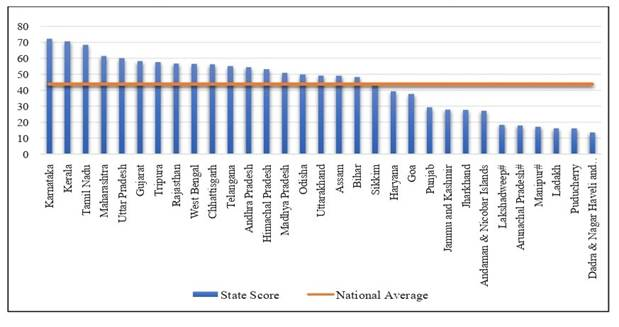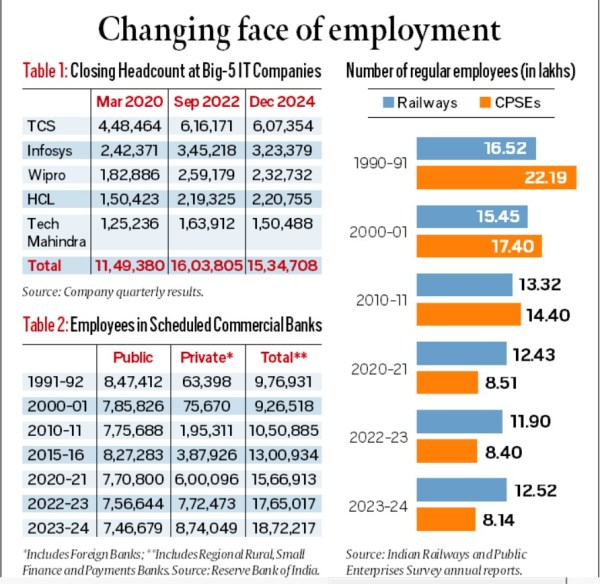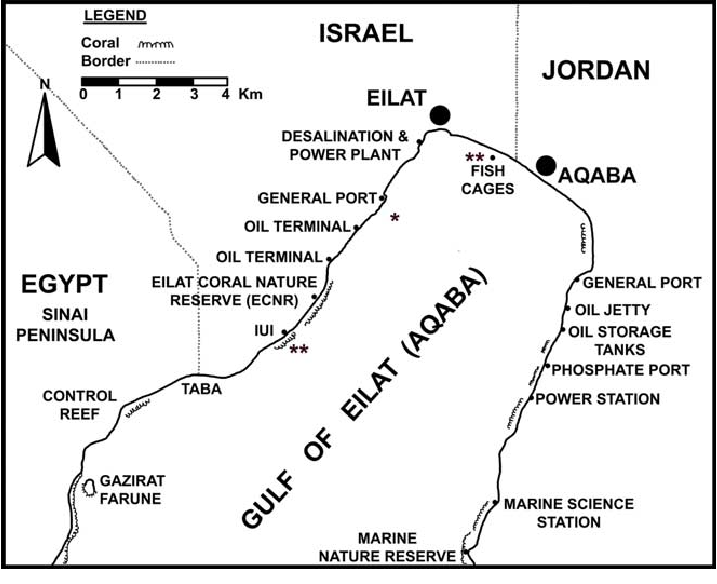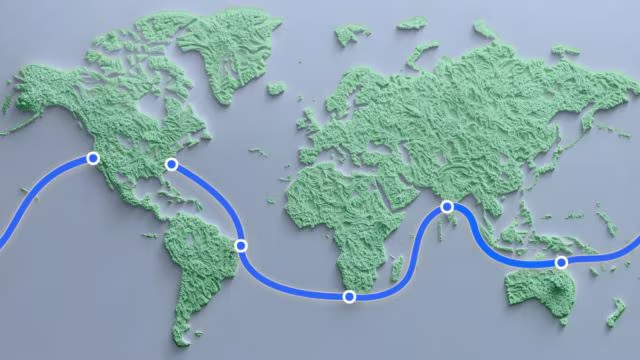Indian Ocean: Strategic Significance & India’s Role
Syllabus: GS2/ IR
In Context
- External Affairs Minister S. Jaishankar emphasized the need for a “coordinated flotilla” to promote stability and cooperation in the Indian Ocean Region (IOR).
- His remarks highlight the growing geopolitical competition and security challenges in the region, necessitating multilateral maritime collaboration.
About the Indian Ocean
- Geographic Overview:
- Third Largest Ocean: Spans 9,600 km from the Bay of Bengal to Antarctica and 7,800 km from South Africa to Western Australia.
- Coastline: 70,000 km, including major economies like India, Australia, and African nations.
- Population & Coastal Influence: Home to 35% of the world’s population and 40% of the global coastline.
- Historical & Civilizational Significance:
- Named after India, reflecting its historical and cultural influence on maritime trade.
- Served as a key trade route since the first millennium, connecting India with Arab lands, Southeast Asia, and Africa.
- The Silk Route & Spice Trade flourished via the Indian Ocean, linking Europe, Asia, and Africa.
- Strategic Importance:
- A critical global trade route, facilitating 70% of the world’s container traffic.
- 80% of India’s external trade and 90% of its energy imports pass through the Indian Ocean.
- Key oil supply routes from West Asia to India, China, Japan, and Europe traverse the region.
- Control of Maritime Chokepoints: India’s central position in IOR provides strategic leverage over:
- Strait of Hormuz (Iran-Oman) – Vital for oil shipments.
- Bab el-Mandeb (Yemen-Djibouti) – Entry to the Red Sea & Suez Canal.
- Strait of Malacca (Indonesia-Malaysia) – Key trade passage for East Asia.
Challenges in the Indian Ocean Region (IOR)
- Maritime Security Threats: Frequent pirate attacks & trafficking, particularly near Somalia and the Gulf of Aden.
- Economic & Environmental Issues: Overfishing and deep-sea mining threaten marine ecosystems.
- Climate Change & Rising Sea Levels: Small island nations face coastal erosion and submersion risks.
- Humanitarian Crises & Disasters: Natural disasters like cyclones, tsunamis, and oil spills require coordinated disaster response.
- Geopolitical Rivalries: Growing influence of the U.S., China, UK, and France fuels power struggles in the region.
India’s Policy Shift in the Indian Ocean
Strengthening Regional Ties:
- India is actively engaging with IOR nations through:
- Indian Ocean Conference (IOC) – A key diplomatic platform initiated by India.
- Indian Ocean Rim Association (IORA) – Multilateral cooperation on economic and maritime security.
- Indian Ocean Naval Symposium (IONS) – Enhancing naval interoperability and intelligence sharing.
- Colombo Security Conclave – Focuses on maritime security & counterterrorism with Sri Lanka, Maldives, and Mauritius.
SAGAR (Security and Growth for All in the Region):
- Launched in 2015 under PM Modi, this initiative aims to:
- Strengthen India’s leadership in IOR.
- Ensure free and open sea lanes for secure global trade.
- Promote sustainable maritime development.
Enhancing Blue-Water Capabilities:
- Naval Expansion: India is modernizing its navy by inducting indigenous aircraft carriers and advanced submarines.
- Maritime Surveillance: Deployment of P-8I Poseidon aircraft, and satellite-based tracking systems.
- Quad Cooperation: India, U.S., Japan, and Australia collaborate on maritime security, anti-submarine warfare, and intelligence sharing.
Status of Devolution to Panchayats in State 2024
Syllabus: GS2/Polity and Governance
Context
- The Union Ministry of Panchayati Raj has released the report titled ‘Status of Devolution to Panchayats in States – An Indicative Evidence-Based Ranking’ (2024).
About
- The devolution index is an approach in assessing the implementation of 73rd and 74th Amendments and is prepared by the Indian Institute of Public Administration.
- It evaluates the current state of power and resource devolution to Panchayati Raj Institutions across all States and Union Territories.
- States/UTs were ranked as per the six key dimensions of framework, functions, finances, functionaries, capacity enhancement, and accountability.
Need for the Assessment
- The mandatory constitutional provisions— such as regular Panchayat elections by state election commissions, reservations for SCs/STs and women, and the constitution of state finance commissions—have been implemented.
- The devolution of functions, finances, and functionaries to Panchayats has been inconsistent across States.
- The effective local governance cannot be achieved through these transfer mechanisms alone.
- It necessitates ‘capacity enhancement’ measures and ‘accountability’ to ensure fairness and transparency in Panchayat operations.
Major Findings
- Karnataka tops the overall Devolution Index (DI) ranking of the Panchayat Raj system among States, while Kerala and Tamil Nadu are in the second and third spot.
- Devolution has increased from 39.9% to 43.9% between the period 2013-14 to 2021-22.

- With the launch of the Rashtriya Gram Swaraj Abhiyan (RGSA), the capacity enhancement component of the Index during this period has increased from 44% to 54.6%.
- During this period, the component of the Index pertaining to functionaries has seen a substantial jump of more than 10% (from 39.6% to 50.9%).
- In the framework criterion, Kerala ranks first followed by Maharashtra, Karnataka, and Haryana.
- In the functional criterion, Tamil Nadu tops the list followed by Karnataka, Odisha, and Rajasthan.
- In the finances criterion, Karnataka has secured the top place followed by Kerala, Tamil Nadu, and Rajasthan.
- In the functionaries criterion, Gujarat ranks first followed by Tamil Nadu and Kerala.
- In the capacity building criterion, Telangana has secured the first spot followed by Tamil Nadu and Gujarat.
Challenges Identified in Report
- Legal and Institutional Gaps: Some states have not conducted regular panchayat elections.
- Limited Role in Policy Implementation: Panchayats have a nominal role in major centrally sponsored schemes (MGNREGA, PMAY, NHM, etc.).
- Disparities Among States: Some states perform significantly better due to strong governance structures and legal provisions, while others struggle due to poor implementation and political unwillingness.
- Low Public Participation: Gram Sabhas, which are essential for participatory governance, are often poorly attended and lack effectiveness.
Recommendations and Suggestions
- Strengthening the Legal Framework: Ensure regular and timely elections for panchayats.
- Empower State Election Commissions (SECs) to function independently without state government interference.
- Financial Empowerment: Establish a Consolidated Fund for Local Government to provide direct and assured funding to panchayats.
- Implement recommendations of the 16th Finance Commission to ensure panchayats receive an adequate share of GST revenues.
- Enhancing Functional Autonomy: Decentralize key service delivery functions to ensure panchayats play a leading role in rural development.
- Promoting Accountability & Transparency: Strengthen Gram Sabha participation by making them more accessible and effective.
India-U.S. Partnership on Underwater Domain Awareness (UDA) Technologies
Syllabus: GS2/ IR
In News
- India and the United States strengthen cooperation in Underwater Domain Awareness (UDA) with the launch of the Autonomous Systems Industry Alliance (ASIA) during the PM Modi visit to the US.
About
- Underwater Domain Awareness (UDA) refers to the capability of a nation or an organization to monitor, detect, and assess activities occurring beneath the surface of water bodies like oceans and seas.
- It plays a crucial role in maritime security, resource management, environmental protection, and disaster response.
- This collaboration marks a historic first—India is the only country with which the U.S. defense industry has offered to work on such sensitive technologies.
Significance of India-U.S. UDA Cooperation
- Geopolitical and Strategic Importance: Strengthening Maritime Domain Awareness (MDA) and Underwater Domain Awareness (UDA) is crucial for India’s national security, particularly due to:
- China’s growing naval presence in the Indian Ocean Region (IOR).
- The need for enhanced submarine detection and tracking capabilities.
- Increased cooperation within the Quad (India, U.S., Australia, Japan) to counter common threats.
- Defense Technology Collaboration: The U.S. has offered several cutting-edge underwater surveillance and anti-submarine warfare (ASW) technologies, including:
- Sea Picket: An autonomous sonar surveillance system by Thayer Mahan.
- Wave Glider: Unmanned Surface Vehicle (USV) by Boeing’s Liquid Robotics, with plans for co-production with Sagar Defence Engineering (60 units).
- Low-Frequency Active Towed Sonar: Discussions underway between L3 Harris and Bharat Electronics Limited (BEL).
- Impact on India’s Defense Capabilities: India’s anti-submarine warfare (ASW) capabilities will be significantly strengthened, complementing existing assets such as:
- 12 P-8I Poseidon Maritime Patrol Aircraft already in service.
- 24 MH-60R Multi-Role Helicopters (being inducted).
- 15 MQ-9B Sea Guardian UAVs, part of a 31-unit contract with deliveries starting from 2029.
- Technology Transfer, Make-in-India, and Economic Impact: First-of-its-kind co-production and technology transfer in sensitive underwater systems.
- Strengthens India’s defense manufacturing ecosystem under Make in India & Atmanirbhar Bharat.
Challenges and Considerations
- Technology Transfer and Data Security: Concerns over sharing sensitive UDA data and sovereign control over surveillance systems.
- Financial and Operational Challenges: High cost of procurement, deployment, and maintenance of advanced underwater systems.
- Technology Dependence: Advanced sonar and AI systems require high-end research and funding.
- Legal and Diplomatic Complexities: Underwater domain awareness in disputed waters can create tensions with neighboring nations.
- Environmental Impact: Use of sonar technologies can impact marine biodiversity and aquatic ecosystems.
Conclusion
- Underwater Domain Awareness (UDA) is a critical component of maritime security, economic sustainability, and environmental conservation. Given the growing Chinese presence in the Indian Ocean, India’s focus on UDA, in collaboration with the U.S. and Quad partners, will significantly enhance its maritime defense capabilities and strategic positioning.
Urban Environmental Protests: Chipko Legacy in Cities
Syllabus: GS3/Environment; Conservation
Context
- Recently, Pune in Maharashtra witnessed a resurgence of debate between development and environmental conservation after ‘Chalo Chipko’ protest against the Pune Riverfront Development Project, echoing the spirit of the Chipko Movement of 1970s.
About the Chipko Movement
- It began in 1973 in the Chamoli district of Uttarakhand (then part of Uttar Pradesh).
- It was led by villagers, particularly women, who physically embraced trees to prevent their felling by government-backed logging operation.
- Prominent figures like Sunderlal Bahuguna and Gaura Devi played a vital role in mobilizing people and highlighting the link between environmental conservation and sustainable development.
Key Features
- Grassroots Activism: The movement was led by local communities, especially rural women, who understood the ecological value of forests for their survival.
- Non-Violent Resistance: Inspired by Gandhian principles, the protesters used peaceful means such as tree-hugging and sit-ins to prevent deforestation.
- Environmental Awareness: The movement raised awareness about the importance of forests in preventing soil erosion, sustaining agriculture, and maintaining biodiversity.
- Policy Impact: The protests eventually led to a government-imposed ban on commercial deforestation in the Himalayan region in 1980.
Urban Environmental Protests: Chipko Legacy in Cities
- Cities face unique environmental issues such as air pollution, water scarcity, loss of green spaces, and climate change-induced disasters.
- In response, urban activists and citizens have taken a stand to protect the environment through protests, legal action, and advocacy.
| Common Threads Between Chipko & Modern Urban Protests | ||
| Aspect | Chipko Movement | Urban Environmental Protests |
| Issue Addressed | Deforestation & loss of biodiversity | Air pollution, deforestation, land use change |
| Mode of Protest | Tree-hugging, sit-ins, marches | Legal petitions, protests, social media campaigns |
| Key Participants | Rural women, villagers | Urban residents, activists, students |
| Government Response | Policy bans on deforestation | Mixed—some policy wins, ongoing legal battles |
Contemporary Urban Environmental Protests Inspired by Chipko:
- Save Aarey Forest Movement (Mumbai, Maharashtra): It emerged to protest against the felling of over 2,700 trees in the Aarey Colony for a metro car shed project.
- Activists and residents used Chipko-style protests, hugging trees and forming human chains to prevent deforestation.
- Save Aravalli Campaign (Gurugram): Residents and environmentalists have been protesting illegal mining and real estate encroachments in the Aravalli hills, emphasizing the range’s role in air purification and as a barrier against desertification.
- Citizen-Led Protests Against Air Pollution (Delhi & NCR): Delhi frequently ranks among the world’s most polluted cities.
- Campaigns like Right to Clean Air and My Right to Breathe have demanded policy changes similar to how Chipko activists fought for forest protection.
- Save Lakes Movements (Bengaluru & Hyderabad): Campaigns such as SaveBellandur Lake and Save Ulsoor Lake aim to protect the city’s rapidly disappearing water bodies from pollution and encroachment.
- Citizen groups have staged protests, filed public interest litigations (PILs), and organized clean-up drives, echoing the Chipko spirit of local community action.
- Raahgiri Movement (Gurugram & Other Cities): It advocates for pedestrian-friendly and vehicle-free streets to reduce urban pollution and promote sustainable urban mobility.
- Similar to Chipko, it is a community-led initiative focusing on reclaiming public spaces for people rather than vehicles.
Challenges & Future of Environmental Protests
- Government & Corporate Resistance: Large-scale infrastructure projects often prioritize economic gains over environmental concerns.
- Public Apathy: Unlike the direct impact of deforestation on rural communities, urban environmental issues can feel distant to many city dwellers.
- Legal Battles: Environmental protests frequently lead to long and complex legal battles, delaying solutions.
- However, with increasing climate awareness and the rise of youth-led movements like Fridays for Future India, environmental activism is gaining momentum.
Conclusion
- The legacy of the Chipko Movement extends beyond its immediate achievements. It has become a symbol of grassroots activism and ecological consciousness, inspiring environmental movements worldwide.
- The movement’s emphasis on nonviolent resistance and community involvement continues to resonate with contemporary environmental activists.
Changing Employment Sector in India
Syllabus: GS3/Economy
Context
- The trend of organised employment has been shifting from the public to private sector — especially post the economic reforms of 1991.
About
- India’s middle class after Independence was largely created by the public sector.
- Employment in the public sector stood at 194.7 lakh and that in the organised private sector only at 80.6 lakh in 1995.
- The employees in the central and state governments plus quasi-governments (public sector undertakings) and local bodies — fell to 176.1 lakh and the latter rose to 119.7 lakh by 2012.
Major Trends
- Regular employees with the Indian Railways: Between 1990-91 and 2022-23, these plunged from 16.5 lakh to 11.9 lakh.
- Employees in the IT Sector: Tata Consultancy Services (TCS) and Infosys already had 45,714 and 36,750 employees respectively at the end of 2004-05, which rose to 4,48,464 and 2,42,371 fifteen years later.
- Banking sector transformation: In 1991-92, of the total employee strength of the scheduled commercial banks in India the Public sector banks had a share of 87%.
- At the end of 2023-24, the private employee strength was 8.74 lakh, as against the less than 7.5 lakh of public sector banks.

Reasons for the Transformation of Working Middle Class in India:
- Economic Liberalization: Post-1991 reforms opened up the economy, leading to the growth of the private sector and more job opportunities.
- Higher Salaries and Benefits: The private sector often offers better pay, career growth, and benefits compared to public sector jobs, attracting the middle class.
- Improved Work Culture: It provides a more dynamic and performance-driven environment, which appeals to the ambitious working middle class.
- Limited Public Sector Jobs: The growth of public sector jobs has stagnated, and competition for these positions is high, making private sector jobs more attractive.
- Entrepreneurial Opportunities: The rise in entrepreneurial ventures and startups has encouraged the middle class to shift towards private businesses and self-employment.
Challenges faced by India
- Employment in the Agriculture Sector: India has not experienced structural transformation of surplus labour from agriculture to other sectors.
- As per the Periodic Labour Force Surveys (PLFS) farm sector’s share in India’s workforce decreased from 64% in 1993-94 to 42.5% in 2018-19, but is subsequently going up to 46.2% in 2023-24.
- Most services sector jobs are informal and low-paying:
- India with almost 85% informal labour is generating more than half of the country’s GDP.
- A high proportion of socially and economically underprivileged sections of society are concentrated in informal economic activities.
Reasons for Increase in the Share of Informal Sector in India’s Employment:
- Unskilled Labour: The education system emphasises theoretical knowledge over practical proficiency. This approach renders new graduates ill-prepared to meet industry demands.
- Rural-Urban Divide: Inaccessible areas are hardly getting quality programmes for their training and industry exposure.
- Technological Changes: The rise of gig economy platforms and casual labor opportunities has expanded the informal sector.
- Flexibility: Many workers prefer the flexibility of informal work, even though it lacks benefits like healthcare and pensions.
Challenges Related to Informal Sector in India
- Low Wages and Exploitation: Informal employment, by definition, lacks a written contract, paid leave, and hence does not pay minimum wages or pay attention to working conditions.
- Lack of Social Security: Workers in the informal sector often lack access to social security benefits such as healthcare, pensions, and unemployment insurance.
- Limited Access to Finance: Informal sector workers and businesses often struggle to access formal financial services such as bank loans and credit.
- Poor Quality of Life: Unorganized sector workers were far more likely to be poor than their organised sector counterparts.
Way Forward
- Bridging the Gap in Education: Aligning Education with Industry Demand Changes will prepare students for real-world challenges.
- Government Initiatives: The programmes can focus on areas like installation of solar energy, waste management, and precision agriculture.
- Public-private partnerships in the green sector can ensure that such training is relevant and impactful.
- Strengthening Rural Skilling Initiatives: Leveraging technology to scale online platforms can ensure equitable access to quality education.
- Incentivising for Retention of Employees: Offering tailored upskilling programmes, encouraging inclusive work cultures, and having mental health support can enhance employee satisfaction and retention.
OTHERS:
Gulf of Eilat (Gulf of Aqaba)
Syllabus: GS1/ Places In News
In News
- Recent research has uncovered a significant pause in coral reef growth in the Gulf of Eilat (Gulf of Aqaba).
About Gulf of Eilat
- Location: Northern tip of the Red Sea, between the Sinai & Arabian Peninsulas.

- Bordering Countries: Egypt, Israel, Jordan, and Saudi Arabia.
- Depth & Contrast: The Gulf of Aqaba is deep (1,850 meters), unlike the much shallower Gulf of Suez (100 meters).
- Coral Resources: The Gulf of Aqaba is notable for its coral reef ecosystems, which are among the world’s northernmost coral reefs.
Source: TH
Development and Commercialisation of Typhoid Vaccine
Syllabus: GS2/ Health
In News
- The Indian Council of Medical Research (ICMR) is seeking expressions of interest (EoI) for the joint development and commercialization of a Typhoid and Paratyphoid vaccine.
| – Manufacturers/companies must meet technical requirements and will be shortlisted based on research and development plans, facilities, and capabilities. |
Typhoid
- Typhoid is a bacterial infection caused by Salmonella Typhi, spread through contaminated food, water, or contact with infected individuals.
- It can be life-threatening without treatment, and antibiotics like chloramphenicol, ampicillin, or ciprofloxacin are used for treatment.
- Typhoid Burden: Typhoid fever is a significant public health issue in India, with approximately 4.5 million cases annually, especially in urban areas, making it a major health concern.
- Vaccines in India: Typhoid vaccines available in India include Typbar-TCV, Ty21a, Typhim Vi, and Typherix. Typhoid conjugate vaccines (TCVs) are for children over 6 months, while Vi vaccines are for children over 2 years. TCVs are currently available only in the private sector.
- Latest Developments : The ICMR-National Institute for Research in Bacterial Infections (NIRBI) has developed a technology for an enteric fever vaccine based on outer membrane vesicles from two strains of typhoidal Salmonella.
Source :TH
Medical Termination of Pregnancy (MTP) Act
Syllabus: GS2/Health
Context
- The Bombay High Court allowed a woman to terminate her 25-week pregnancy in a private hospital.
Abortion Laws in India
- The Medical Termination of Pregnancy (MTP) Act permits abortions in specific predetermined situations.
- Before the enactment of the MTP Act in 1971, the medical termination of pregnancy was governed by the Indian Penal Code (IPC).
- Most of these provisions aimed at criminalising abortions, except where the procedure was done in good faith in order to save the woman’s life.
- The provisions failed to make a distinction between wanted and unwanted pregnancies, making it extremely onerous for women to access safe abortions.
- In 1971, the MTP Act was enacted by Parliament as a “health” measure, to decriminalise abortion in certain defined circumstances and under due supervision of registered medical practitioners.
- A pregnancy could only be terminated under Section 3(2) if it did not exceed 20 weeks.
- It laid down that the pregnancy can be terminated on the opinion of one doctor if it is done within 12 weeks of conception and two doctors if it is done between 12 and 20 weeks.
- The 2021 amendment to the MTP Act: Rule 3B permitted abortion up to 24 weeks for women due to change of marital status during the ongoing pregnancy, besides in cases of survivors of rape, victims of incest, and other vulnerable women.
- It also replaced the word “by any married woman or her husband” with the words “any woman or her partner”, bringing within the fold of the law pregnancies outside marriage institutions.
- After 24 weeks, the MTP Act requires medical boards of expert doctors to be set up by the state government in each district, which opine on whether to allow termination of pregnancy in case of substantial foetal abnormality.
Source: IE
Russia’s MRNA Based Cancer Vaccine
Syllabus: GS2/ Health
In News
- Russia has announced the development of an mRNA-based personalized cancer vaccine, expected to be available free for patients by early 2025.
| Messenger RNA (mRNA) – It is a type of single-stranded RNA involved in protein synthesis. mRNA is made from a DNA template during the process of transcription. – The role of mRNA is to carry protein information from the DNA in a cell’s nucleus to the cell’s cytoplasm (watery interior), where the protein-making machinery reads the mRNA sequence and translates each three-base codon into its corresponding amino acid in a growing protein chain. |
mRNA Vaccine Technology
- Messenger RNA vaccines gained attention during the COVID-19 pandemic following the use of this technology to manufacture vaccines.
- mRNA vaccines provide genetic information to teach the body’s cells to produce antigens, which can trigger an immune response to target and attack cancer cells.
- Features : mRNA cancer vaccines are a form of immunotherapy, designed to boost the immune system to detect and destroy cancer cells, preventing their spread without damaging healthy cells.
- Unlike traditional vaccines, cancer mRNA vaccines are personalized for each patient to target specific antigens present on their tumors, making them potentially more effective.
Global Research:
- Other countries, including the UK and the US, are also researching cancer vaccines.
- The UK’s NHS launched the Cancer Vaccine Launch Pad in collaboration with BioNTech, and CureVac in the US has announced a promising mRNA cancer vaccine for glioblastoma.
| Do you know ? – Cancer is a large group of diseases that can start in almost any organ or tissue of the body when abnormal cells grow uncontrollably, go beyond their usual boundaries to invade adjoining parts of the body and/or spread to other organs. – In India, around 100 out of every 1 lakh people are diagnosed with cancer. – The Union Budget 2025-26 emphasizes strengthening cancer care with initiatives like Day Care Cancer Centres and customs duty exemptions on life-saving drugs. |
Source :TH
Sovereign Green Bonds
Syllabus: GS3/Economy
Context
- Like several emerging markets, India also turned to sovereign green bonds to help fund its transition to a low-carbon economy, but investor demand remains weak.
About
- Since 2022-23, India has issued SGrBs eight times, and raised almost Rs 53,000 crore.
- India’s SGrB issues have struggled to gain traction due to muted investor demand, making it difficult for the government to secure a greenium.
- Globally, greeniums have reached 7-8 basis points, in India it is often at just 2–3 basis points.
Green Bonds
- Green bonds are debt instruments issued by governments, corporations, and multilateral banks to raise funds for projects that reduce emissions or enhance climate resilience.
- Issuers typically offer green bonds at lower yields than conventional bonds, assuring investors that the proceeds will be used exclusively for green investments.
- Greenium: The difference in yield — known as the green premium, or greenium — determines the cost advantage of green bonds.
- A higher greenium allows issuers to raise funds at lower costs, making green investments more attractive.
- Sovereign green bonds (SGrBs) are those that are issued by sovereign entities, like the Government of India, which formulated a framework for issuing such bonds in 2022.
- The framework defines “green projects” as those that encourage energy efficiency in resource utilisation, reduce carbon emissions, promote climate resilience, and improve natural ecosystems.
Source: IE
Project Waterworth
Syllabus: GS3/ S&T
In News
- Meta has announced an ambitious undersea cable initiative called Project Waterworth to enhance global digital connectivity.

About Project Waterworth
- It is an AI-powered subsea cable system, spanning 50,000 km across five continents and is the longest and highest-capacity subsea cable system, linking the U.S., India, Brazil, South Africa, and other key regions.
- The cables will be laid at depths of up to 7,000 meters in deep waters and advanced burial techniques in high-risk shallow waters will protect the cables from ship anchors and environmental hazards.
- The initiative will introduce three new oceanic corridors, improving the scale and reliability of internet networks.
- Greater connectivity will enhance international cooperation, digital inclusion, and technological advancements.
